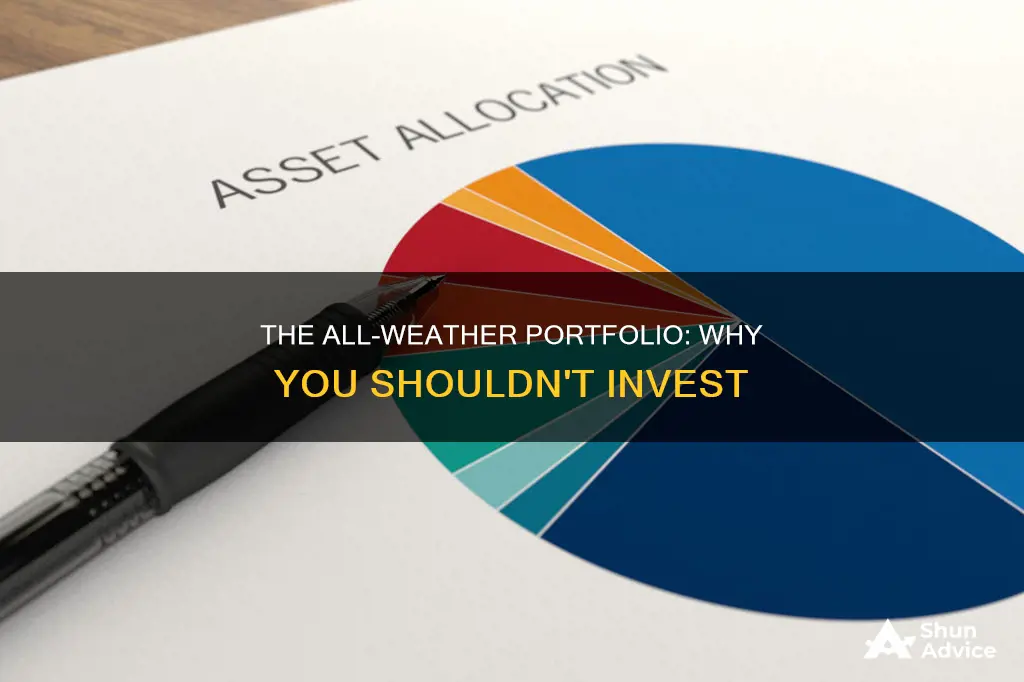
The All Weather Portfolio is a diversified, low-risk portfolio designed by Ray Dalio of Bridgewater Associates to perform well in all economic climates. The portfolio is constructed to weather economic storms, hence its name. It is made up of asset classes that perform well in different economic seasons, namely rising prices (inflation), falling prices (deflation), rising growth (bull markets), and falling growth (bear markets). The portfolio is mostly bonds, with 40% long-term treasury bonds, 15% intermediate-term treasury bonds, and 30% stocks.
However, there are some drawbacks to the All Weather Portfolio. Firstly, it may not be suitable for investors seeking high growth, as portfolios with a higher weight in equities tend to outperform over the long run. Secondly, it requires a certain level of hands-off detachment, as some of the individual assets, such as gold, can experience extended drawdowns. Finally, while the portfolio has performed well historically, there is no guarantee that it will continue to do so in the future.
| Characteristics | Values |
|---|---|
| Creator | Ray Dalio |
| Creator's Firm | Bridgewater Associates |
| Creator's Firm Asset Management | Over $150 billion |
| Asset Mix | 30% stocks, 55% bonds, 15% commodities |
| Performance (Jan 2008 – Oct 2024) | 6% compound annual return |
| Performance (Jan 1871 – Oct 2024) | 7.71% compound annual return |
| Risk Level | Medium |
| Best Suited For | Investors with a balanced approach to risk and return |
What You'll Learn
- The All Weather Portfolio is not suitable for investors seeking high growth
- It is not recommended for investors who focus on the performance of individual positions
- The portfolio's risk-averse nature may limit returns
- The All Weather Portfolio may underperform in extreme market conditions
- The approach requires careful adherence to its key principles

The All Weather Portfolio is not suitable for investors seeking high growth
The All Weather Portfolio is a well-diversified, low-risk portfolio designed by Ray Dalio to perform well under different economic conditions. While the portfolio has proven to be stable and successful, it may not be suitable for investors seeking high growth. Here's why:
- Lower Returns: The All Weather Portfolio prioritises stability and risk management over maximising returns. With a relatively low allocation of 30% to stocks, the portfolio may underperform during high growth periods. Historical data shows that portfolios with a higher weight in equities tend to provide higher returns over the long run. For instance, from 1973-2024, the All Weather Portfolio returned 4.6% annually compared to 6.5% for the S&P 500. While the difference may seem small, it can add up significantly over time.
- Risk Aversion: The All Weather Portfolio is designed to weather any financial climate, including inflation, deflation, rising growth, and declining growth. To achieve this stability, the portfolio has a higher allocation to bonds (55%) than stocks (30%) and includes assets like gold and commodities (15%) that perform well during inflation. While this diversification minimises risk, it may limit the portfolio's upside potential. Investors seeking high growth may prefer strategies that take on more risk to capture larger returns.
- Rebalancing Requirements: To maintain the desired risk profile, the All Weather Portfolio requires regular rebalancing. This involves monitoring the portfolio and adjusting the allocation of assets to restore their original balance. While rebalancing helps maintain the intended risk-return profile, it can be time-consuming and may not align with the goals of investors seeking high growth.
- Emotional Factors: The All Weather Portfolio is designed for investors who get emotional about losing money and want a simple way to preserve their capital with decent growth. If an investor's primary goal is to maximise returns and they are comfortable with higher risk, the All Weather Portfolio's conservative nature may not align with their objectives.
In conclusion, while the All Weather Portfolio offers stability and risk management, it may not be suitable for investors seeking high growth due to its lower returns, risk-averse nature, rebalancing requirements, and emotional factors. Investors seeking high growth may prefer strategies with higher allocations to equities and a willingness to take on more risk to capture larger returns.
Illiquid Investments: Which Portfolio Has the Least Liquidity?
You may want to see also

It is not recommended for investors who focus on the performance of individual positions
The All Weather Portfolio is an investment portfolio designed to perform well under different economic conditions. The portfolio is made up of 55% US bonds, 30% US stocks, and 15% hard assets (gold and commodities).
The All Weather Portfolio is not recommended for investors who focus on the performance of individual positions. This is because the portfolio includes assets like gold and commodities, which can be difficult to hold on to as individual assets. Gold, for example, can have decades-long drawdowns and it can be challenging for investors to stick with it as an individual asset.
If you are an investor who focuses a lot on the performance of individual positions, you may find it challenging to adopt the All Weather Portfolio.
Calculating ROI on Your Investment Portfolio: A Step-by-Step Guide
You may want to see also

The portfolio's risk-averse nature may limit returns
The All Weather Portfolio is a diversified asset mix designed to perform well under different economic environments. The portfolio is made up of 55% US bonds, 30% US stocks, and 15% hard assets (gold and commodities).
The All Weather Portfolio's heavy emphasis on bonds, which constitute 55% of the portfolio, may be seen as a disadvantage by investors seeking higher returns. Bonds are often associated with lower returns compared to stocks, and a significant allocation to bonds may limit the overall return potential of the portfolio.
Additionally, the portfolio's relatively low allocation to stocks, at only 30%, may be viewed as a disadvantage by investors seeking higher growth. Stocks typically offer higher returns over the long run, and a lower allocation to stocks may result in lower overall returns for the portfolio.
The portfolio's allocation to gold and commodities, which make up 15% of the portfolio, may also be considered a disadvantage by some investors. These assets can be highly volatile and may underperform in certain market conditions, potentially limiting the portfolio's overall returns.
While the All Weather Portfolio offers stability and risk diversification, its risk-averse nature may limit returns, particularly in favourable market conditions. This trade-off between stability and return potential is an important consideration for investors when evaluating the suitability of the All Weather Portfolio for their investment goals and risk tolerance.
The PVF Savings Investment: A Smart Financial Move
You may want to see also

The All Weather Portfolio may underperform in extreme market conditions
The All Weather Portfolio is an investment portfolio designed to perform well under different economic conditions. It was created by Ray Dalio and his firm Bridgewater Associates, one of the largest hedge funds in the world. The portfolio consists of 55% U.S. bonds, 30% U.S. stocks, and 15% hard assets (gold and commodities).
The All Weather Portfolio has historically performed well during challenging market conditions, including the financial crisis in 2008/09, the Covid-19 pandemic in 2020, and the bear market of 2022. Its defensive nature has resulted in smaller drawdowns compared to stocks.
However, the portfolio may underperform in extreme market conditions, such as during strong bull markets. Since the All Weather Portfolio has a relatively low allocation to stocks (30%), it may underperform portfolios with a higher weight to equities in a high growth environment. For example, during the bull markets of the 1980s, 1990s, and the 2010s, the All Weather Portfolio underperformed the S&P 500 and a traditional 60/40 portfolio.
Additionally, the All Weather Portfolio may not be suitable for investors seeking high growth or those who want to maximize their returns. The portfolio prioritizes defense and risk mitigation over aggressive growth, and its primary goal is to preserve capital. As a result, it may underperform portfolios with a higher allocation to equities over the long run.
Furthermore, the All Weather Portfolio's heavy allocation to bonds may be a concern for some investors. Bonds have historically provided stable returns and served as a hedge against stock downturns. However, in a rising rate environment, bonds may underperform other asset classes. While the All Weather Portfolio can still provide diversification benefits, rising rates may lead to lower returns for the portfolio going forward compared to previous decades.
In summary, while the All Weather Portfolio offers lower drawdowns and stable returns, it may underperform in extreme market conditions, particularly during strong bull markets. It is important for investors to understand the potential trade-offs between lower risk and higher returns when considering the All Weather Portfolio or any other investment strategy.
Monitoring Your Investment Portfolio: A Comprehensive Guide
You may want to see also

The approach requires careful adherence to its key principles
The All Weather Portfolio is a diversified asset mix introduced by hedge fund manager Ray Dalio. It is designed to perform well during both favourable and unfavorable economic and market conditions. The portfolio consists of 30% stocks, 55% bonds, and 15% commodities.
- Regular rebalancing: The portfolio should be rebalanced at least annually to maintain the original asset allocation. This is important because assets can rise or fall in value over time, and rebalancing helps to reduce the level of risk in the portfolio.
- Systematic approach: The portfolio should be based on a systematic approach to investing, using mathematical models and algorithms to analyse the market and make decisions.
- Liquid assets: The portfolio should include liquid assets, such as short-term bonds, that can be sold quickly if needed.
- Risk management: The portfolio is designed to minimise risks and optimise risk management. The different asset classes in the portfolio have varying degrees of risk protection.
- Investor objectives: The asset allocation in the portfolio should be tailored to the investor's individual objectives and attitude to risk.
By carefully adhering to these principles, investors can aim to achieve the stable returns and risk diversification offered by the All Weather Portfolio.
Understanding the Efficient Frontier: Maximizing Investment Portfolio Returns
You may want to see also
Frequently asked questions
The All Weather Portfolio is an investment portfolio designed to perform well under different economic conditions. It consists of a mix of assets, including stocks, bonds, and hard assets like gold and commodities. The portfolio aims to provide stable returns and reduce the impact of market volatility.
The All Weather Portfolio was created by Ray Dalio, the founder of Bridgewater Associates, one of the largest hedge funds in the world. Dalio developed this portfolio to perform well in various economic environments and manage risks effectively.
The All Weather Portfolio offers stability of returns and risk diversification. It is designed to provide consistent returns with minimal drawdowns, making it suitable for investors who want to preserve their capital with decent growth. The portfolio has a well-balanced mix of assets, including stocks, bonds, gold, and commodities, which helps reduce overall risk.
To build an All Weather Portfolio, you can invest in a selection of low-cost exchange-traded funds (ETFs). The asset allocation typically includes stocks, bonds, and commodities. You can choose specific ETFs that match your investment goals and risk tolerance. It is recommended to rebalance your portfolio periodically to maintain the desired asset allocation.
One disadvantage of the All Weather Portfolio is that it may lag in performance compared to other approaches, especially in extreme market conditions. The focus on risk management and stability may limit the potential returns. Additionally, the portfolio requires careful adherence to its key principles, and investors need to monitor and rebalance their portfolios regularly.







